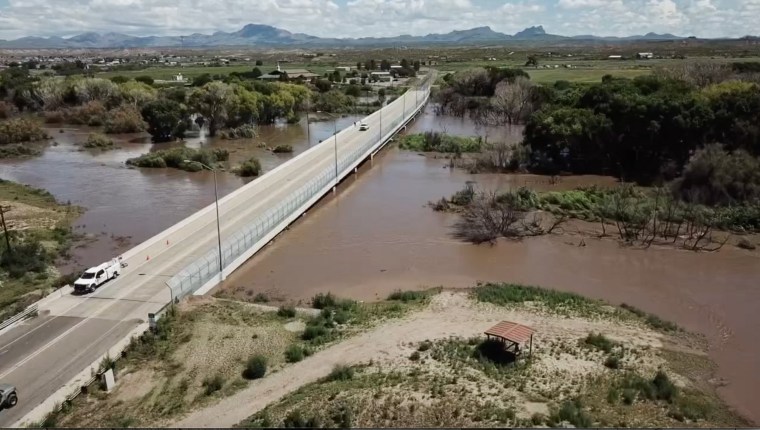The Southwest's dangerous flooding Monday overwhelmed the Old West town of Duncan, Arizona, prompting "mass evacuation" and a local state of emergency.
The Duncan Valley Rural Fire District declared the "mass evacuation of flood prone areas in Duncan" early Monday, listing more than a dozen streets in the 712-person town as subject to the order.
Mayor Anne Thurman declared the state of emergency shortly after noon. She cited rainfall since Aug. 15, dangerous flooding and "extreme peril to life and property," according to the declaration.
Thurman formally asked the state for first responder resources.

In an afternoon update, the town said new concerns about the integrity of a century-old river levee that had been breached earlier Monday means evacuees should continue to stay away.
The Gila River, which runs through town on its journey from Gila National Forest in New Mexico to the Colorado River in Yuma, crested after 7 a.m. at 2.5 feet above what's considered its flood state, federal forecasters said.
Images obtained by NBC News showed the river encroaching on the town as floodwaters took over some streets and a gas station, where the ground was covered in a shallow layer of still water. No injuries have been reported.
Flash flooding isn’t unusual in the Southwest at this time of year, when summer heat rapidly sends evaporated humidity into thunderous, towering clouds. They return the favor with rain and monsoonal weather that can feel almost tropical. Brief, powerful showers cover desert floors, create brief moments of pooling and revive the driest creeks.
Monday's weather was different.
It sent sustained precipitation from north of Duncan into major waterways like the Gila, which will remain overflowing for hours, if not days, as floodwaters continue to swell its tributaries.
The railroad town, officially placed on the U.S. Postal Service map in 1883, when it was called Purdy, is 5 miles from New Mexico and inseparable from the river.
"Duncan belongs to the Gila," the town's website says.
Rob Howlett, a meteorologist with the National Weather Service's Tucson office, said the Duncan area hasn't seen flooding like this for more than 15 years.
"There’s been a lot of rainfall at the headwaters of the Gila River in New Mexico," he said. "It's coming downstream in our area."
Although the worst might be behind it, the Gila could display higher, wider waters along its path for days, he said, as thunderstorm activity was forecast for the area anew.
A warning from the National Weather Service said moderate flooding was likely for the Gila through Duncan overnight.
"Motorists should not attempt to drive around barricades or drive cars through flooded areas," the agency said. "Caution is urged when walking near riverbanks."
A front that stalled over Texas was typical of the weather that has produced a torrent of rain in Dallas, where nearly 8 inches fell in three hours overnight, Howlett said.
Authorities at Zion National Park in Utah, just north of the Arizona state line, continued to search for missing visitor Jetal Agnihotri of Tucson after flash flooding swept some park-goers off their feet Friday. All were accounted for except Agnihotri, last seen near the Virgin River Narrows.
Climate change hasn't been blamed for the specific events in Dallas, Duncan and elsewhere in the Southwest, but the extreme weather is consistent with earth scientists' contention that a warming planet will bring more frequent and more intense storm activity.
Showers will continue on and off for the next few days from eastern Arizona to Texas and beyond, federal forecasters said.
The remnants of a tropical storm system in northern Mexico moved into the Gulf of California and supplied the Southwest with a spigot of precipitation, Howlett said.
Thunderstorms continued to develop over Duncan on Monday afternoon.
